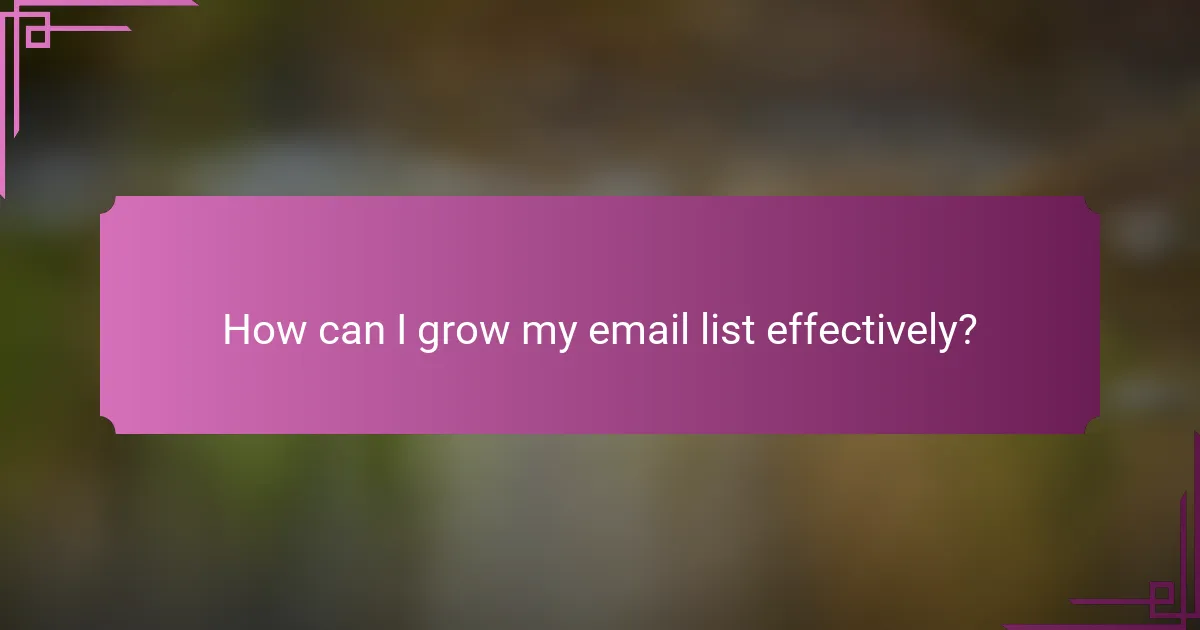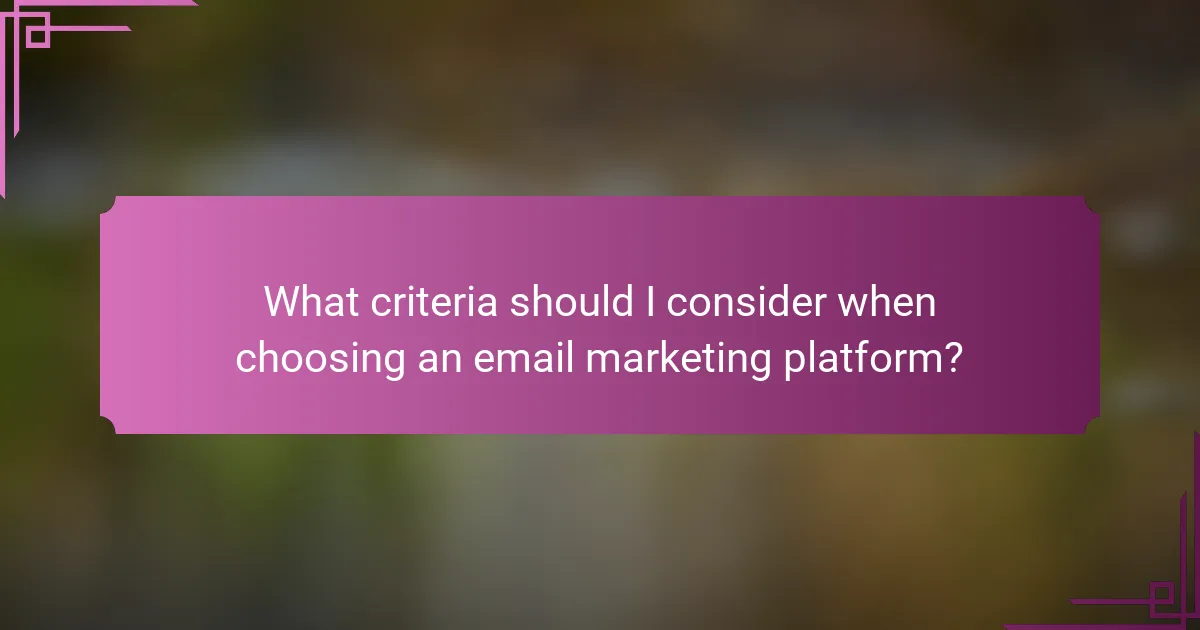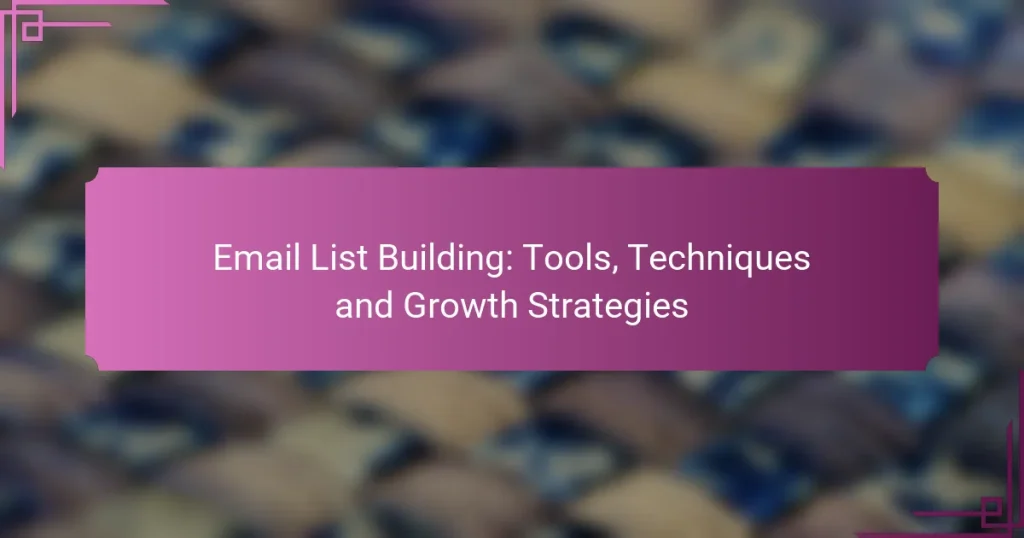Email list building is a crucial aspect of digital marketing, enabling businesses to connect with their audience directly. By utilizing the right tools and techniques, such as automation and segmentation, you can effectively grow your subscriber base and enhance engagement. Offering valuable content and incentives, along with strategic promotion, will further accelerate your email list growth.

What are the best tools for email list building?
The best tools for email list building help you create, manage, and grow your subscriber base effectively. They offer features like automation, analytics, and customizable templates to enhance your email marketing strategy.
Mailchimp
Mailchimp is a popular email marketing platform known for its user-friendly interface and robust features. It allows you to create sign-up forms, manage contacts, and send targeted campaigns.
With a free tier available for smaller lists, Mailchimp is ideal for beginners. However, as your list grows, pricing can increase significantly, so consider your long-term needs before committing.
ConvertKit
ConvertKit is designed specifically for creators, offering features that cater to bloggers, podcasters, and other content producers. Its visual automation builder simplifies the process of creating complex email sequences.
This tool emphasizes landing pages and sign-up forms, making it easy to capture leads. While it may lack some advanced features of competitors, its focus on simplicity and effectiveness is a strong selling point.
AWeber
AWeber is a long-standing email marketing service that provides a range of tools for list building and management. It offers a variety of templates and a drag-and-drop editor for easy campaign creation.
One notable feature is its split testing, which allows you to optimize your emails for better performance. AWeber’s pricing is competitive, but it may not be as flexible for larger businesses compared to other options.
ActiveCampaign
ActiveCampaign combines email marketing with customer relationship management (CRM) capabilities. This integration allows for advanced segmentation and personalized messaging based on user behavior.
While it offers powerful automation features, the learning curve can be steep for beginners. ActiveCampaign is best suited for businesses looking for a comprehensive solution that goes beyond basic email marketing.
GetResponse
GetResponse is an all-in-one marketing platform that includes email marketing, landing pages, and webinars. Its automation features are robust, allowing for tailored customer journeys.
GetResponse offers a free trial, making it easy to test its features before committing. However, its pricing structure can be complex, so review the plans carefully to find the best fit for your needs.

How can I grow my email list effectively?
To grow your email list effectively, focus on providing value to your audience through engaging content and incentives. Implementing strategies like content upgrades, lead magnets, and social media promotion can significantly increase your subscriber base.
Content upgrades
Content upgrades are targeted offers that enhance existing content, encouraging visitors to subscribe in exchange for additional resources. For example, if you have a blog post about email marketing tips, you could offer a downloadable checklist or eBook related to that topic as a content upgrade.
To implement content upgrades, ensure they are relevant and valuable to the content they accompany. Use clear calls-to-action (CTAs) to guide users toward the upgrade, and consider using tools like pop-ups or inline forms to capture email addresses.
Lead magnets
Lead magnets are incentives designed to attract potential subscribers by offering something of value, such as free trials, discounts, or exclusive content. A well-crafted lead magnet can significantly boost your email sign-up rate.
When creating lead magnets, ensure they align with your target audience’s interests. For instance, a fitness coach might offer a free workout plan, while a financial advisor could provide a budgeting template. Keep the lead magnet easy to access and promote it across your platforms.
Social media promotion
Promoting your email list on social media is an effective way to reach a broader audience. Share engaging posts that highlight the benefits of subscribing, and include direct links to your sign-up forms.
Utilize various social media platforms to maximize reach. For example, you can create eye-catching graphics for Instagram, informative posts for LinkedIn, or engaging videos for Facebook. Consider running targeted ads to boost visibility and attract more subscribers.
Landing pages
Landing pages are dedicated web pages designed specifically for capturing email sign-ups. A well-optimized landing page focuses on a single goal: converting visitors into subscribers.
To create effective landing pages, keep the design simple and the messaging clear. Use strong headlines, compelling CTAs, and testimonials to build trust. A/B testing different elements, such as headlines or images, can help identify what resonates best with your audience.

What are the key techniques for email list segmentation?
Email list segmentation involves dividing your email subscribers into specific groups based on shared characteristics. This targeted approach enhances engagement and improves the effectiveness of your email marketing campaigns.
Demographic segmentation
Demographic segmentation categorizes subscribers based on attributes such as age, gender, income, and education level. This method allows marketers to tailor content to resonate with specific groups, increasing the likelihood of engagement.
For example, a fashion retailer might send different promotions to younger audiences compared to older customers. Understanding these demographics can help optimize messaging and product offerings.
Behavioral segmentation
Behavioral segmentation focuses on subscribers’ interactions with your brand, including purchase history, website activity, and email engagement. By analyzing these behaviors, you can create targeted campaigns that address specific needs and preferences.
For instance, customers who frequently open emails but rarely make purchases may benefit from special offers or reminders. Tracking user behavior helps refine your approach and improve conversion rates.
Geographic segmentation
Geographic segmentation divides your email list based on the physical locations of subscribers. This technique is particularly useful for businesses with regional offerings or localized promotions, allowing for more relevant messaging.
For example, a restaurant chain might send different menus or promotions based on the city or region. Additionally, understanding local regulations or cultural preferences can enhance the effectiveness of your campaigns.

What criteria should I consider when choosing an email marketing platform?
When selecting an email marketing platform, consider factors such as pricing plans, ease of use, and integration capabilities. These criteria will help ensure that the platform meets your needs and supports your marketing goals effectively.
Pricing plans
Pricing plans vary significantly among email marketing platforms, often based on the number of subscribers or emails sent per month. Look for options that fit your budget, typically ranging from free tiers for small lists to monthly fees in the low hundreds for larger businesses.
Some platforms offer pay-as-you-go options, while others have flat-rate pricing. Evaluate whether the cost aligns with your expected growth and marketing budget.
Ease of use
An intuitive interface is crucial for efficiently managing your email campaigns. Choose a platform that allows you to create, edit, and schedule emails without extensive technical knowledge.
Look for features like drag-and-drop editors, pre-designed templates, and user-friendly dashboards. A platform with a steep learning curve can hinder your productivity and campaign effectiveness.
Integration capabilities
Integration with other tools, such as CRM systems, e-commerce platforms, and analytics software, enhances the functionality of your email marketing efforts. Ensure the platform you choose can seamlessly connect with the tools you currently use.
Check for available integrations and APIs that allow for data synchronization. This can streamline your workflow and improve the overall effectiveness of your marketing strategies.

What are the common mistakes in email list building?
Common mistakes in email list building can significantly hinder your growth and engagement. These errors often stem from a lack of strategy, leading to ineffective practices that fail to attract or retain subscribers.
Neglecting mobile optimization
Neglecting mobile optimization is a critical mistake that can alienate a large portion of your audience. With a significant number of users accessing emails on mobile devices, failing to ensure your emails are mobile-friendly can result in poor user experience and lower engagement rates.
To optimize for mobile, use responsive design techniques that allow your emails to adapt to various screen sizes. Keep your layouts simple, use larger fonts, and ensure buttons are easily clickable. Aim for a single-column layout to enhance readability on smaller screens.
Additionally, test your emails on multiple devices and email clients before sending. Tools like Litmus or Email on Acid can help you preview how your emails will appear across different platforms. Remember, a well-optimized email can improve open rates by a notable percentage, leading to better overall performance in your email campaigns.


